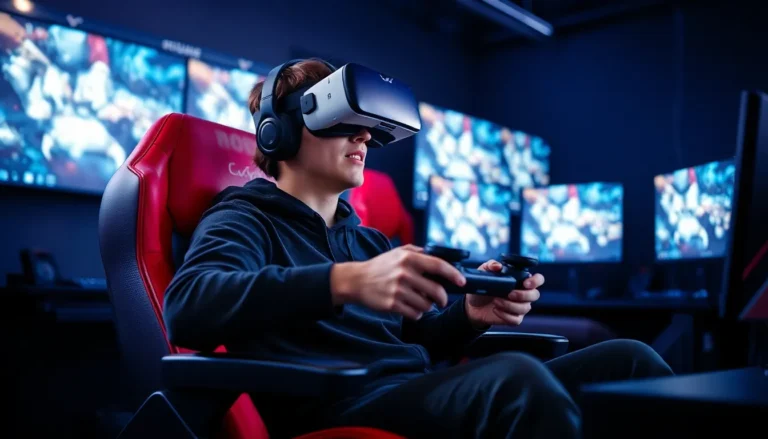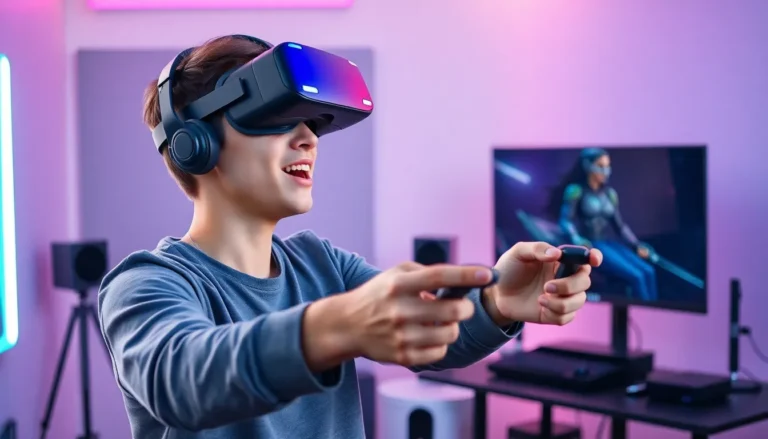In the vibrant world of virtual reality, players expect nothing less than an immersive experience that transports them to fantastical realms. However, when frame rates drop and graphics lag, the magic can quickly fade, leaving players feeling like they’re stuck in a pixelated time warp. That’s where VR game optimization swoops in like a superhero in a spandex suit, ready to save the day.
Table of Contents
ToggleOverview of VR Game Optimization
VR game optimization focuses on improving the performance and quality of virtual reality experiences. Players expect seamless experiences, and any issues can lead to immersion disruption. Frame rate consistency and low latency significantly contribute to this optimization.
Developers utilize various techniques to enhance VR performance. Techniques include increasing frame rates to at least 90 FPS, minimizing motion blur, and optimizing graphical fidelity. Properly adjusted graphics settings can significantly enhance visual clarity.
The use of tools, such as profiling software, helps identify bottlenecks in performance. Profiling assists in understanding where the system struggles, whether it’s the graphics, CPU, or another component. Making informed adjustments based on profiling results improves overall gaming experience.
Hardware optimization also plays a critical role. High-performance graphics cards, sufficient RAM, and compatible VR headsets enhance gameplay. Systems must meet or exceed recommended specifications to ensure smooth running of VR titles.
Software updates frequently address bugs and performance hiccups. Developers often release patches that improve engine performance or fix specific issues. Regularly updating game software can lead to a more stable virtual environment.
Lastly, user feedback informs developers about optimization areas. Community insights can lead developers to specific issues often overlooked during testing. Prioritizing player experience fosters a more enjoyable and immersive gaming atmosphere.
Importance of VR Game Optimization

VR game optimization plays a crucial role in delivering an immersive experience that players expect. Focus on enhancing performance and quality proves vital for engaging gameplay.
Enhanced User Experience
Players enjoy a seamless and interactive experience, thanks to optimized VR games. Frame rate consistency enhances fluidity, reducing issues like motion sickness. Visualization improves with optimized graphics, leading to lifelike environments. Developers prioritize user feedback to address specific concerns, refining gameplay based on real-time experiences. An engaged player base emerges as developers listen and adapt. Effective optimization techniques significantly increase overall satisfaction, keeping players invested in the gaming world.
Increased Performance Efficiency
Performance efficiency directly impacts gameplay fluidity. Maintaining a minimum of 90 FPS is essential for an optimal experience. Developers utilize techniques like reducing graphical detail without sacrificing quality. Profiling software identifies bottlenecks, allowing for targeted enhancements. Implementing higher performance graphics cards and sufficient RAM contributes to smooth gameplay. Up-to-date software ensures that bugs and performance issues are addressed continuously. Optimized performance leads to higher player retention and satisfaction, solidifying the game’s success in a competitive market.
Techniques for VR Game Optimization
Effective VR game optimization relies on various techniques that enhance the immersive experience. Key areas of focus include asset management, rendering techniques, and performance profiling.
Asset Management
Asset management involves organizing and optimizing game assets for improved performance. Developers prioritize efficient use of textures and models to minimize memory usage. Reducing polygon counts in 3D models ensures quicker loading times without sacrificing visual quality. Utilizing Level of Detail (LOD) techniques allows a game to dynamically adjust detail based on the player’s distance from objects. This approach conserves resources while maintaining an engaging visual experience. Moreover, developers can employ texture atlases that consolidate smaller textures into larger ones, reducing the number of draw calls and enhancing performance.
Rendering Techniques
Rendering techniques significantly impact VR performance by affecting frame rates and visual fidelity. Implementing techniques like occlusion culling allows the engine to render only visible objects, reducing graphical load. Techniques such as foveated rendering prioritize rendering detail where a player’s gaze is focused, optimizing resources effectively. Developers can also use post-processing effects judiciously to enhance visual quality without taxing resources excessively. Setting resolution and frame rate targets at a minimum of 90 FPS is essential for ensuring smooth gameplay and reducing motion sickness. This combination of strategies yields a more immersive experience for players.
Performance Profiling
Performance profiling plays a critical role in identifying and addressing bottlenecks during development. Using profiling tools, developers can monitor frame rates, CPU and GPU usage, and memory consumption in real-time. This insight helps pinpoint issues that negatively affect performance. Regular testing throughout the development cycle ensures that adjustments are made proactively. Developers prioritize feedback from testing sessions to refine gameplay based on observed performance metrics. Continuous profiling fosters an iterative process, enabling teams to deliver a polished, high-performing VR game experience that meets player expectations.
Tools for VR Game Optimization
Utilizing the right tools is essential for effective VR game optimization. These tools enhance performance and ensure a streamlined gaming experience.
VR Development Frameworks
VR development frameworks streamline the creation of VR games. Engines like Unity and Unreal Engine provide robust features for building immersive environments. Unity allows developers to effectively manage assets through its integrated tools, while Unreal Engine offers advanced rendering options for stunning visuals. Each framework includes plugins that improve performance and support a variety of VR headsets. Compatibility with multiple devices ensures wider accessibility, allowing developers to reach more players.
Profiling and Benchmarking Tools
Profiling and benchmarking tools play a critical role in identifying performance issues. Tools such as NVIDIA Nsight and Intel’s GPA assist developers in monitoring real-time performance metrics. These tools help reveal bottlenecks and inefficiencies in gameplay. By leveraging detailed analytics, developers can pinpoint areas needing improvement. Benchmarking enables comparison against industry standards, guiding performance optimization efforts. Regular use of these tools fosters an environment where developers can create highly optimized VR experiences, enhancing overall player satisfaction.
VR game optimization stands as a vital component in crafting engaging and immersive experiences. By addressing performance issues and enhancing graphical fidelity developers can significantly elevate player satisfaction. The integration of advanced techniques and tools ensures that VR games not only meet but exceed player expectations.
As the gaming landscape continues to evolve the focus on optimization will only intensify. Developers who prioritize seamless gameplay and responsive environments will likely see increased player retention and loyalty. Ultimately investing in VR game optimization is essential for creating captivating virtual worlds that keep players coming back for more.





